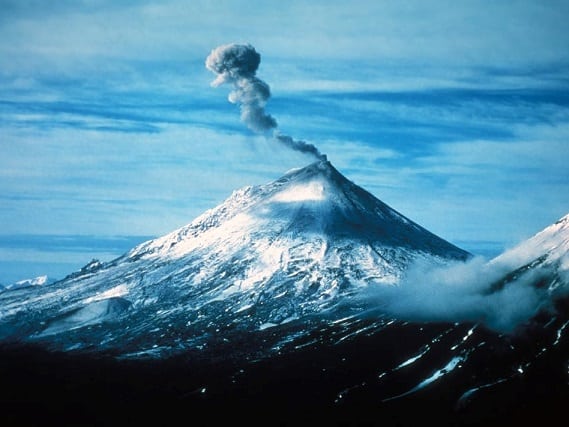
 An Alaskan volcano that erupted in March is set to blow once again according to scientists at the Alaska Volcano Observatory.
An Alaskan volcano that erupted in March is set to blow once again according to scientists at the Alaska Volcano Observatory.
Located along the southern edge of the Alaska Peninsula, Pavlof Volcano is one of the most active volcanos in North America with over half a dozen eruptions during the past three decades alone and more than 40 since the late 1700s when record-keeping for the area began. Its most recent eruption occurred on March 27 of this year when it sent a volcanic ash cloud 37,000 feet into the air and covered the tiny coastal village of Nelson Lagoon with ash.
The Alaska Volcano Observatory (AVO) Friday upgraded Pavlof’s status from “normal” to a “volcano watch” and raised its aviation colour code to orange in response to new seismic activity beneath the volcano, indicating the potential for a low-level eruption.
“As it was starting to trend up over the last several hours, we thought it prudent to increase our alert level,” Schneider said.
“This is what the beginning of an eruption looks like. We’re continuing to watch carefully and see how this develops,” says AVO geophysicist Dave Schneider.
Pavlof’s March eruption caused the cancellation of close to 70 Alaska Airlines flights over two days as the cloud of volcanic ash drifted across the Alaska interior and into northern Canada. Researchers have been able to use data from Alaska’s recent volcanic activity -from Pavlof volcano but also from Mount Cleveland and Mount Veniaminof– to refine a new method for detecting volcano eruptions at remote locales such as those in the Alaska Peninsula.
In a study published in the Bulletin of the Seismological Society of America, lead author David Fee of the AVO and his research team analyzed data from ground-coupled airwaves or GCAs that occur when volcanic explosions produce low-frequency sound waves that impact the earth’s surface. The team found that in contrast to other methods used to monitor volcanic activity such as seismic detection (using energy waves moving through the earth), thermal detection (recording changes in heat patterns) and even the use of satellite imagery, acoustic or infrasound detection can accurately pinpoint eruptions and distinguish between subsurface movement at a volcano and surface explosions.
“Volcanic explosions can sometimes be difficult to detect seismically, but the GCA can provide unambiguous evidence that a volcano is erupting,” says Fee. “The techniques we used provide an automated way to detect, locate, characterize, and monitor volcanic eruptions, particularly in remote, difficult-to-monitor regions like Alaska.”
Residents near the Popcatepetl volcano in Mexico are fearing a major eruption as the volcano has once again begun to release steam and gas while tremors are being reported in the region. An explosion just a few weeks ago on April 16 sent hot rocks into the air along with clouds of ash and flowing lava. Mexico’s second highest peak, Popcateptl is located 70 kilometres southeast of Mexico City. In the year 2000, an eruption at Popcateptl forced 40,000 people to evacuate the surrounding area.
Leave a Reply
You must be logged in to post a comment.




 Share
Share Tweet
Tweet Share
Share




Comment